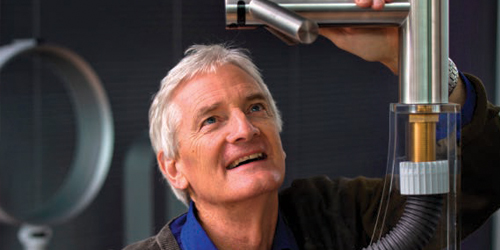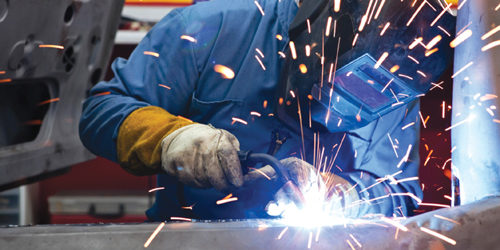
The humble vacuum cleaner was invented in the UK by Hubert Cecil Booth in 1901. As usual, the Americans got their hands on it and the Hoover Company was launched, selling vacuum cleaners door to door to alleviate the housewife’s burden of cleaning.
Unusually for such designs that start in the UK and get ‘hoovered’ up by the Americans, we have grabbed back this design via the industrial design talent of a man from Cromer in Norfolk. This man from Norfolk is now worth £3 billion.
James Dyson was born in 1947 and in his early days he excelled at long-distance running: “I was quite good at it, not because l was physically good, but because l had more determination. I learnt determination from it.” He spent a year at the Byam Shaw School of Art and then studied furniture and interior design at the Royal College of Art before moving into engineering.
Dyson helped design the Sea Truck in 1970 while studying at the Royal College of Art. His original invention, the Ballbarrow, was a modified version of a wheelbarrow, using a ball instead of a wheel. This was featured on the BBC’s Tomorrow’s World television programme. Dyson stuck with the idea of a ball, which his brother had thought of, inventing the Trolleyball, a trolley that launched boats. He then designed the Wheelboat, which could travel at speeds of 40 mph on both land and water.
In the late 1970s, Dyson had the idea of using cyclonic separation to create a vacuum cleaner that would not lose suction as it picked up dirt. He became frustrated with his Hoover Junior’s diminishing performance: the dust bag kept becoming clogged with excessive dust, thus reducing suction. The cyclone idea came from a sawmill that used cyclone technology. During a visit to a local sawmill, Dyson noticed how the sawdust was removed from the air by large industrial cyclones. Centrifugal separators are a typical method of collecting dirt, dust and debris in industrial settings. Such methods usually were not applied on a smaller scale because of the higher cost. Dyson reportedly hypothesised the same principle might work, on a smaller scale, in a vacuum cleaner. He removed the bag from the Hoover Junior and fitted it with a cardboard cyclone. On cleaning the room with it, he found it picked up more than his bag machine. This was the first vacuum cleaner without a bag.
Partly supported by his wife’s salary as an art teacher, and after five years and many prototypes, Dyson launched the “G-Force” cleaner in 1983. However, no manufacturer or distributor would handle his product in the UK, as it would disturb the valuable market for replacement dust bags, so Dyson launched it in Japan through catalogue sales. Manufactured in bright pink, the G-Force sold for the equivalent of £2,000. It won the 1991 International Design Fair Prize in Japan and he obtained his first US patent on the idea in 1986.
After failing to sell his invention to the major manufacturers, Dyson set up his own manufacturing company, Dyson Ltd, and in June 1993, he opened his research centre and factory in Malmesbury, Wiltshire.
Dyson’s breakthrough in the UK market came more than ten years after the initial idea, through a TV advertising campaign in which it was emphasised that, unlike most of its rivals, the Dyson vacuum did not require the continuing purchase of replacement bags. At that time, the UK market for disposable cleaner bags was worth over £100 million. The slogan “say goodbye to the bag” proved more attractive to the buying public than a previous emphasis on the suction efficiency that its technology delivered. Ironically, the previous step change in domestic vacuum cleaner design had been the introduction of the disposable bag — users being prepared to pay extra for the convenience. The Dyson Dual Cyclone became the fastest-selling vacuum cleaner ever made in the UK, and outsold those of some of the companies that rejected his idea, becoming one of the most popular brands in the UK.
In early 2005, it was reported that Dyson cleaners had become the market leaders in the United States by value (though not by number of units sold).
Following his success, other major manufacturers began to market their own cyclonic vacuum cleaners. In 1999 Dyson sued Hoover (UK) for patent infringement. The High Court ruled that Hoover had deliberately copied a fundamental part of his patented designs in making its Triple Vortex bagless vacuum cleaner range. Hoover agreed to pay damages of £4 million.
In 2005, Dyson incorporated the wheel ball from his Ballbarrow concept into a vacuum cleaner, creating the Dyson Ball, with the aim of making it more manoeuvrable.
To prove the theory that failure maketh the man, this industrial genius was not always successful as, in 2000, he expanded his appliance range to include a washing machine called the ContraRotator, which had two rotating drums moving in opposite directions. The range was decorated in the usual bright Dyson colours, rather than the traditional white, grey or black of most other machines. The item was not a commercial success and is no longer available.
In October 2006 Dyson launched the Dyson Airblade, a fast hand dryer that uses a thin sheet of moving air as a squeegee to remove water, rather than attempting to evaporate it with heat. This allows faster drying, while using much less energy than traditional electrical hand dryers. Another product is a fan without external blades, which he calls the “Air Multiplier”. In addition to a cooling fan, a model which distributes electrically-produced heat and an ultrasonic humidifier model are also available.
In 1998, Dyson was one of the chairmen and chief executives of the twenty FTSE 100 companies who signed a statement published in The Financial Times calling on the government for early British membership of the Eurozone. He claimed that failure to join the Euro would lead to the destruction of the British manufacturing base and said: “It does not mean that the jobs will go tomorrow but will drift abroad over a period and the longer-term future of Britain as a manufacturing nation will be blighted. Ministers had better understand that if we delay entry too long there may be nothing left to save.”
Claiming that the strength of the pound was affecting his company’s profits on exports to France and Germany, in 2000 Dyson threatened to shift focus from his Wiltshire plant to a new plant set up in Malaysia because the government would not join the euro. He said: “We would expect to double in size in the next two years. We are talking about a £100 million investment and up to 2,000 jobs. I would like to make that investment in the UK but it seems that is not going to be possible. The value of sterling means we are struggling to compete at home with cheap imports from Europe and the Far East. We do around £40 million worth of export business with France and Germany each year but we aren’t making any money. If we joined the euro we would be on an even footing with our biggest trading partners.”
At the time, an editorial published by The Times responded: “Mr Dyson, a manufacturing version of Sir Richard Branson, likes complaining. Yesterday he was complaining that Britain’s failure to join the Euro and the resultant strong pound will force him to move abroad. Last week he blamed the price of land and planning delays in Wiltshire. So where will he go? To Portugal, Italy or to an EU candidate such as Poland? No, Mr Dyson threatens to go to the Far East. Like so many entrepreneurs, he wants a cheap currency and low interest rates, but also low inflation, low wages, a flexible labour market and low regulation. He will not find them in the eurozone.” Lord Tebbit, a former Secretary of State for Trade and Industry, also questioned Dyson’s motives and said: “What still puzzles me is why such a euro-enthusiast as Mr Dyson does not intend to establish his new factory in Europe if he can’t have it in Britain.” In 2014, Dyson said he would now be voting to leave the European Union to avoid being “dominated and bullied by the Germans.”
This brings us bang up to date with the looming EU referendum and shows that the opinion of industry cannot always be trusted as they have their own vested interests that might not chime with the best interests of this country. Dyson’s demand to join the Euro was motivated by the best interests of his company and certainly not those of the UK.
With the Dyson invention taking the world by storm and adding billions to his bank account, he turned his attention to the nurturing of British engineering talent and created the James Dyson Foundation to support design and engineering education. It now operates in UK, US and Japan. The Foundation’s aim is to inspire young people to study engineering and become engineers by encouraging students to think differently and to make mistakes. The Foundation supports engineering education in schools and universities, as well as medical and scientific research in partnership with
charities. It achieves this by funding different resources, such as the “Education box”, a box filled with activities for a school to use as a teaching aid.
The Foundation lends the boxes to schools for four weeks free of charge. They are suitable for Key Stage 4 and above. The Education box enables students to take apart and examine a Dyson DC22 Telescope hand held vacuum cleaner. In addition, a school is allowed to retain a James Dyson Foundation teacher pack, and a copy of Genius Of Britain, a Channel 4 TV series featuring Dyson, and design engineering posters. The Foundation also supports the work of young designers through the James Dyson Award. This is an international design award that “celebrates, encourages and inspires
the next generation of design engineers.” It’s run in twenty countries and is open to recent graduates in product design, industrial design, and engineering.
Dyson has always been quite outspoken on the subject of engineering and thinks that people feel it’s all “bearded men in bad jumpers”...or white coats. “Yes, exactly, a terrible image problem, but they’re creative people. They’re creating all day long. That’s the problem I’ve always had with people talking about the ‘creative industries’, it implies that industry isn’t creative. I loathe that. It degrades the whole idea of making things. There is still this snobbery in Britain about that sort of thing. It’s ‘trade’ or ‘new money.’ It’s OK to make money as an artist, but not OK to make money by making things”, he said in a recent interview.
When asked how the UK is fairing in the engineering debate, his response is typically blunt: “ Very badly. We’re filing fewer patents every year, and we’re now 22nd in the world league. Yet, we’re the fifth-largest economy in the world. And we need lots and lots of engineers and can’t get them. If we could double it tomorrow, we would double it tomorrow. There are not enough British students reading engineering at university. Then very, very few stay on to do research. Around 88% of researchers in science and engineering in British universities are from outside the EU. And they are told they have to go home when they finish their degrees because they can’t get a visa. The Dyson Foundation is also trying to get more children interested in engineering. It teaches the valuable life lessons you need. You have to analyse things. You watch failure and overcome failure because you don’t get it right the first time. You go back, you analyse it, you change it, you get it right. That’s what life’s about.”
There was some criticism over his £8 million donation to Cambridge University, being that it is effectively a private company: “Well, yes. But we’re doing all sorts of things. And it’s our free choice. So £6m of that is going into a new postgraduate engineering building, and £2m into an area where graduates and undergraduates can build prototypes, which is so important. We also fund undergraduate bursaries, postgraduate bursaries, because I think the government should subsidise the fees of UK engineering undergraduates. Since there are so few, it wouldn’t cost them very much.”
It would appear that he trusts his intuition over the market research: “Yes, a trite example is the clear bin on the Dyson. As engineers, we got really excited about that, we enjoyed seeing our dirt, and watching it come in. But, when we started selling it, the retailers were appalled: ‘You’ll never sell that. People don’t want to see the dirt.’ We said no, we like it, and did some research, and they were absolutely right. People said they didn’t want to see the dirt, but now every single vacuum cleaner has a see-through bin. I couldn’t prove that people would buy it. The research showed the opposite. But, you have to be brave, you have to risk a lot of money, you have to go into the unknown. It’s risky.”
All of this commercial success has created a multi-billion pound company, yet, unusually, Dyson is still a private company: “It seems that most entrepreneurs just want to make money as quickly as possible, but I didn’t do it for that. We double our investment in research every two years, and couldn’t do that as a public company. They wouldn’t put up with that. We can take a very long-term view. We’re doing lots of research in lots of British universities, and some of it is 20 years old. It won’t happen until I am long retired, and you couldn’t do that if you were a public company”.
Being a private company also allows Dyson to indulge himself and his family, and he answers to no one. He now owns more land in England than the Queen, the Duke of Bedford and the Duke of Marlborough after his latest purchase, a 3,000-acre estate in Lincolnshire, bringing his total land portfolio to 25,000 acres. His main residence is Dodington House, an 18th-century manor house with 51 bedrooms near his engineering base in Wiltshire. With his wife and three children, he also enjoys homes in Chelsea and the South of France and is the owner of the largest British-owned mega-yacht, the Nahlin, which at 91.4 metres, is the 36th largest yacht on the planet. But, not content with just any old yacht, Dyson bought a unique steam powered boat that was built in 1930, having been used by King Edward Vlll and Wallis Simpson during their Adriatic cruises. Getting aboard should be no problem as he has his own £20 million Gulfstream private jet and a £2 million private hanger at Bristol Airport.
So what does the future hold for a man that has everything but still appears to have the rabid thirst for invention and disturbing the status quo? “The future is robotics”.
“We are developing our own robots rather than buying other people’s. We’ve been developing one for 15 years. We’ve been a bit slow about it, but are very ambitious in what we’re doing, so it’s taken us much longer to get there. It’s interesting because it’s slightly difficult to see at this stage where robotic technology is going. We’ve been developing vision systems so that they can interpret what they see. What our robot is doing is behaving like a human. When you vacuum a room, you look and interpret, and that’s what they’re doing. They’re already cleverer than humans in the sense that they remember things. So, when artificial intelligence truly kicks in, then yes, artificial intelligence might well surpass human intelligence. We use robots on our assembly lines because the motor is assembled perfectly every time, every measure is assembled perfectly. We used to batch test; we stopped because there were no failures.”
There are rumours of the Dyson car amongst a myriad of other things. Dyson is not a man who is quitting anytime soon, and as long as the drive to invent is there, we will be hearing much more from the Dyson empire in the future.






